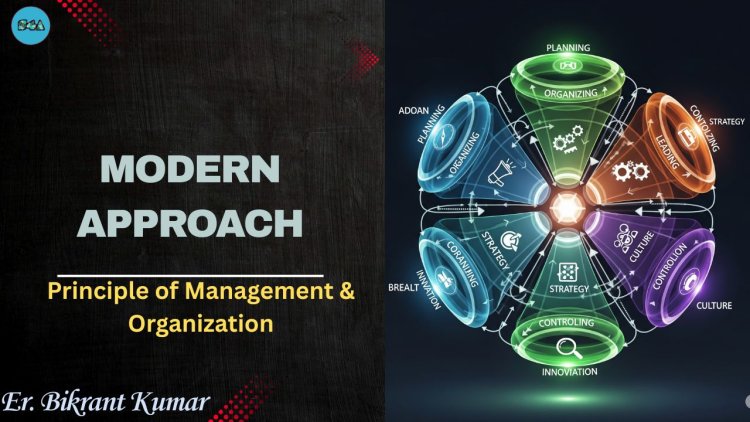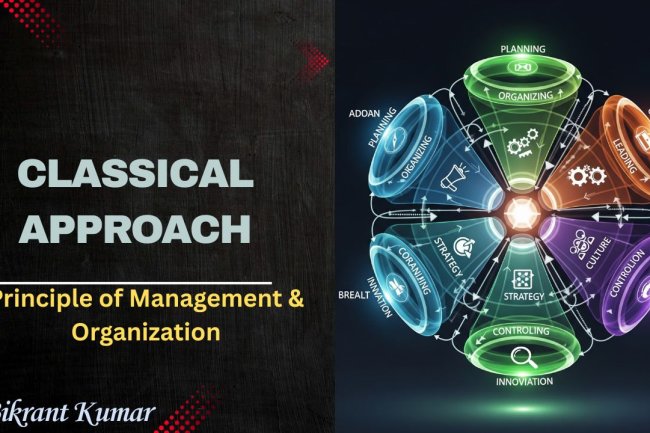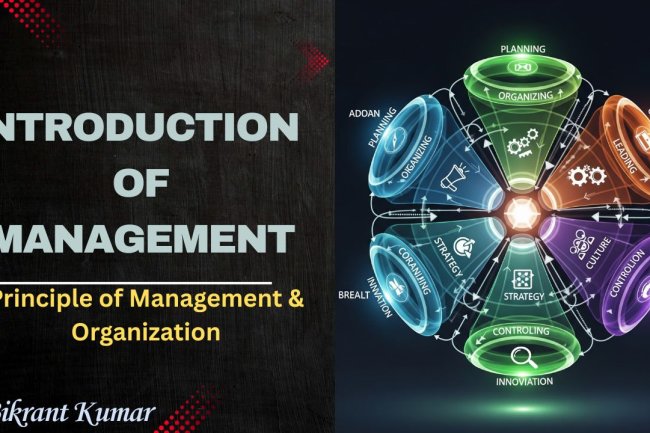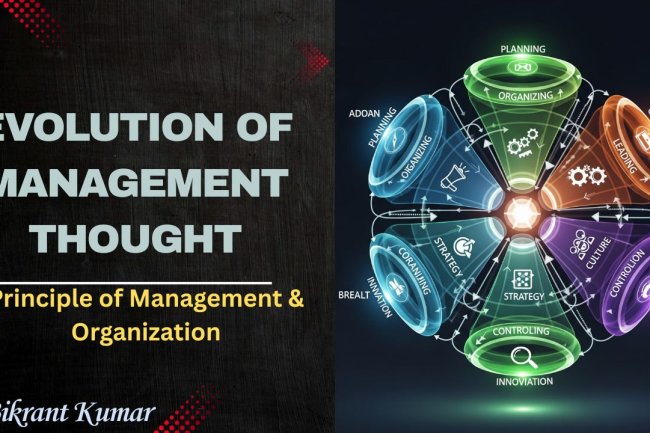Modern Approach
Principle of Management

The Modern Theory of Management evolved as a response to the limitations of both Classical and Neo-Classical theories. It recognizes that organizations are complex, dynamic, and constantly changing systems that must adapt to their internal and external environments.
This theory takes a scientific, flexible, and holistic approach and focuses not only on tasks or people but also on technology, environment, systems, and contingencies.
Modern Theory of Management: An Overview
Duration:
1950s onward (still evolving and used today)
Main Objective: To improve organizational effectiveness by considering:
- People
- Processes
- Technology
- Environment
- Flexibility
Main Types of Modern Management Theory:
- Systems Theory
- Contingency Theory
- Quantitative (Management Science) Theory
Systems Theory
- Key Contributor: Ludwig von Bertalanffy
- From: Austria
- Developed in: 1950s
Objective:
To view an organization as a system of interrelated parts working together toward a common goal.
Concept:
An organization is like a living body made up of parts (departments, people, technology, policies) that must work together.
It interacts with the environment and takes inputs, processes them, and produces outputs.
Key Principles:
- Subsystems must cooperate
- Open system: affected by and affecting the environment
- Feedback is essential for improvement
- Focus on interdependence
Advantages:
- Holistic view of management
- Adapts to environmental changes
- Encourages collaboration between departments
Disadvantages:
- Difficult to manage complex interactions
- Requires strong communication and coordination
- Implementation can be expensive
Real-Life Example:
A university has multiple departments (admission, teaching, library, exam, finance). If they work in isolation, students suffer. If they work together, the system runs smoothly.
Contingency Theory
Key Contributors:
- Fred Fiedler (USA)
- Joan Woodward (UK)
- Paul Lawrence & Jay Lorsch
Developed in: Late 1950s – 1960s
Objective:
There is no one best way to manage. The best approach depends on the situation.
Concept:
Management strategies must change depending on circumstances, such as:
- Technology
- Team size
- Leadership style
- Market demand
- Employee skill level
Key Principles:
- No universal rules
- Managers must adapt strategies
- Flexibility is crucial
- Leadership effectiveness depends on context
Advantages:
- Practical and flexible
- Matches real-life business complexity
- Helps improve performance in changing situations
Disadvantages:
- Difficult to predict best approach in all cases
- Requires constant analysis and change
- May confuse employees if frequent changes happen
Real-Life Example:
A restaurant may use a rigid structure during peak hours for speed but allow flexibility and creativity during quieter times. The manager adapts based on the situation.
Quantitative (Management Science) Theory
Key Contributors:
- George Dantzig (developed Linear Programming)
- Used by military and businesses post World War II
From: USA and UK
Developed in: 1940s–1950s
Objective:
Use mathematics, statistics, and computer models to solve complex management problems and improve decision-making.
Concept:
Decisions should be data-driven, based on logic and models, not just intuition.
Key Principles:
- Use of Operations Research (OR)
- Linear programming
- Decision theory and probability
- Optimization and simulations
Advantages:
- Accurate and reliable decisions
- Helps in planning and scheduling
- Useful for large-scale operations
Disadvantages:
- Not suitable for problems involving human behavior/emotions
- Requires skilled analysts and tools
- Can become over-dependent on data
Real-Life Example:
An airline uses mathematical models to plan routes, manage bookings, fuel use, staff schedules — all based on optimization algorithms.
Core Concept of Modern Theory (in Human Language):
“One size does not fit all. A business is like a living body – all parts must work together and adapt to changes. Good management depends on people, technology, data, and the situation.”
Advantages of Modern Management Theory:
- Flexible and adaptable
- Encourages innovation and technology use
- Scientific and data-driven decision making
- Focuses on the full system and external environment
- Promotes strategic thinking
Disadvantages:
- Complex to implement
- Needs skilled manpower
- Can be costly and time-consuming
- May not suit small or traditional businesses
Comparison Table Summary:
|
Type |
Author(s) |
Focus |
Key Idea |
Example |
|
Systems Theory |
Ludwig von Bertalanffy |
Whole organization as a system |
Interrelated parts work together |
University departments |
|
Contingency Theory |
Fiedler, Woodward, Lawrence |
Situational management |
No one best way – it depends |
Flexible restaurant management |
|
Quantitative Theory |
George Dantzig and others |
Math and data-based decisions |
Use models to optimize decisions |
Airline route optimization |
Real-Life Combined Example:
Imagine Amazon:
- Uses Systems Theory to coordinate warehouses, customer service, logistics, and IT
- Applies Contingency Theory during festive seasons – adjusts policies, delivery timelines, marketing
- Uses Quantitative Models to manage inventory, pricing, delivery routes, and staff planning
This is a perfect Modern Management System — dynamic, scientific, flexible, and efficient.
--------------------------
Files
What's Your Reaction?















